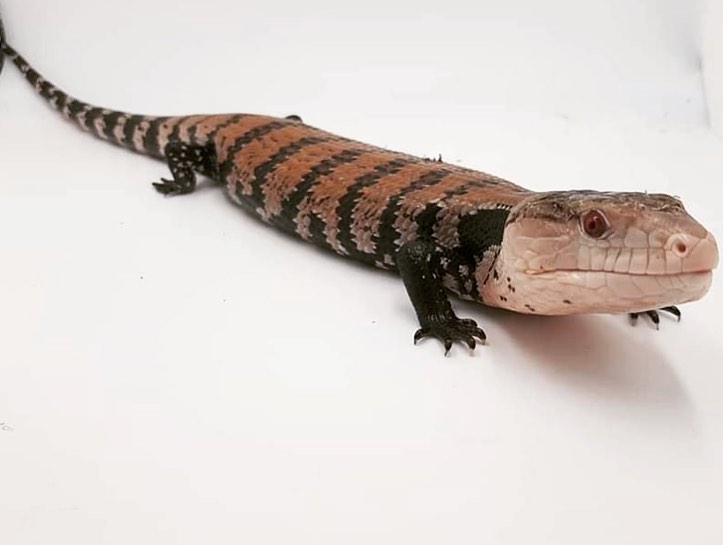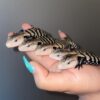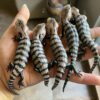Description
Indonesian Blue Tongue Skinks for Sale at Ranch of Exotic Breeds
Are you looking to add a unique and fascinating reptile to your collection? Look no further than the Indonesian Blue Tongue Skink! At Ranch of Exotic Breeds, we specialize in providing healthy, well-cared-for exotic pets, and our Indonesian Blue Tongue Skinks are no exception. These captivating creatures are known for their striking appearance, docile nature, and ease of care, making them an excellent choice for both beginner and experienced reptile keepers.
In this article, we’ll explore everything you need to know about Indonesian Blue Tongue Skinks, including their characteristics, care requirements, and why they make such great pets. Plus, we’ll answer some frequently asked questions to help you make an informed decision.
The Indonesian Blue Tongue Skink is a stunning reptile known for its vibrant blue tongue, which it uses as a defense mechanism. Native to Indonesia, these skinks are ground-dwelling lizards that thrive in tropical environments. They are omnivorous, feeding on a mix of vegetables, fruits, and protein sources like insects and small animals.
At Ranch of Exotic Breeds, we offer healthy, captive-bred Indonesian Blue Tongue Skinks that are perfect for reptile enthusiasts. Our skinks are raised in optimal conditions, ensuring they are well-socialized and ready to become part of your family.
Why Choose an difference between indonesian and northern?
Unique Appearance: With their sleek bodies, distinctive patterns, and bright blue tongues, these skinks are a visual delight.
Docile Temperament: classic indonesian blue tongue skinks are known for their calm and friendly nature, making them easy to handle.
Low Maintenance: Compared to other reptiles, they require relatively simple care, making them ideal for beginners.
Long Lifespan: With proper care, these skinks can live up to 20 years, providing long-term companionship.
Care Guide for Indonesian Blue Tongue Skinks
Habitat Setup
Enclosure: A 40-gallon tank is suitable for an adult skink indonesian and northern re difference. Ensure the enclosure has a secure lid to prevent escapes.
Substrate: Use a mix of coconut fiber, cypress mulch, or reptile-safe soil to mimic their natural environment.
Temperature: Maintain a basking spot of 90-95°F and a cooler side of 75-80°F. Use a heat lamp or under-tank heater halmaheras vs indonesians re.
Humidity: Keep humidity levels between 40-60%. Mist the enclosure regularly to maintain moisture.
Lighting: Provide UVB lighting for 10-12 hours a day to support their calcium metabolism.
Diet
Indonesian Blue Tongue Skinks are omnivores and enjoy a varied diet. Feed them a mix of:
Vegetables: Collard greens, squash, carrots, and sweet potatoes.
Fruits: Berries, bananas, and melons (in moderation).
Protein: Insects (crickets, mealworms), cooked eggs, and lean meats.
Handling and Socialization
These skinks are generally calm and enjoy being handled. Start with short sessions and gradually increase the duration as they become more comfortable. Always support their body and avoid sudden movements.
FAQs About Indonesian Blue Tongue Skinks
1. Are Indonesian Blue Tongue Skinks good for beginners?
Yes! Their docile nature and relatively simple care requirements make them an excellent choice for first-time reptile owners.
2. How big do Indonesian Blue Tongue Skinks get?
They typically grow to 18-24 inches in length, with males being slightly larger than females.
3. What is their lifespan?
With proper care, Indonesian Blue Tongue Skinks can live up to 20 years in captivity.
4. Do they require UVB lighting?
Yes, UVB lighting is essential for their health as it helps them metabolize calcium and prevent metabolic bone disease.
5. Can I house multiple skinks together?
It’s generally not recommended to house multiple skinks together, as they can become territorial and aggressive.
6. What should I do if my skink stops eating?
A loss of appetite can be due to stress, improper temperatures, or illness. Check your setup and consult a reptile veterinarian if the issue persists.
7. Are Indonesian Blue Tongue Skinks venomous?
No, they are not venomous. Their blue tongue is used to scare off predators, but they are harmless to humans.
Why Buy From Ranch of Exotic Breeds?
At Ranch of Exotic Breeds, we are passionate about providing our customers with healthy, well-cared-for exotic pets. When you purchase an Indonesian-Blue Tongue-Skink from us, you can expect:
Health Guarantee: All our skinks are vet-checked and come with a health guarantee.
Expert Support: Our team is always available to answer your questions and provide guidance on care.
Ethical Breeding: We prioritize the well-being of our animals and ensure they are bred and raised in humane conditions northern re difference between indonesian.
Conclusion
The Indonesian Blue Tongue Skink is a remarkable Pet lizards for sale reptile that combines beauty, personality, and ease of care. Whether you’re a seasoned reptile keeper or just starting, this skink is sure to bring joy and fascination to your life.
Ready to welcome an Indonesian Blue Tongue Skink into your home? Visit Ranch of Exotic Breeds today to explore our available skinks and make your purchase. Don’t hesitate to reach out if you have any questions—we’re here to help!
Browse our selection of Lizards for sale Indonesian Blue Tongue Skinks for sale and bring home your new exotic pet or Red bearded dragon
today! Visit Ranch of Exotic Breeds to learn more.












Reviews
There are no reviews yet.